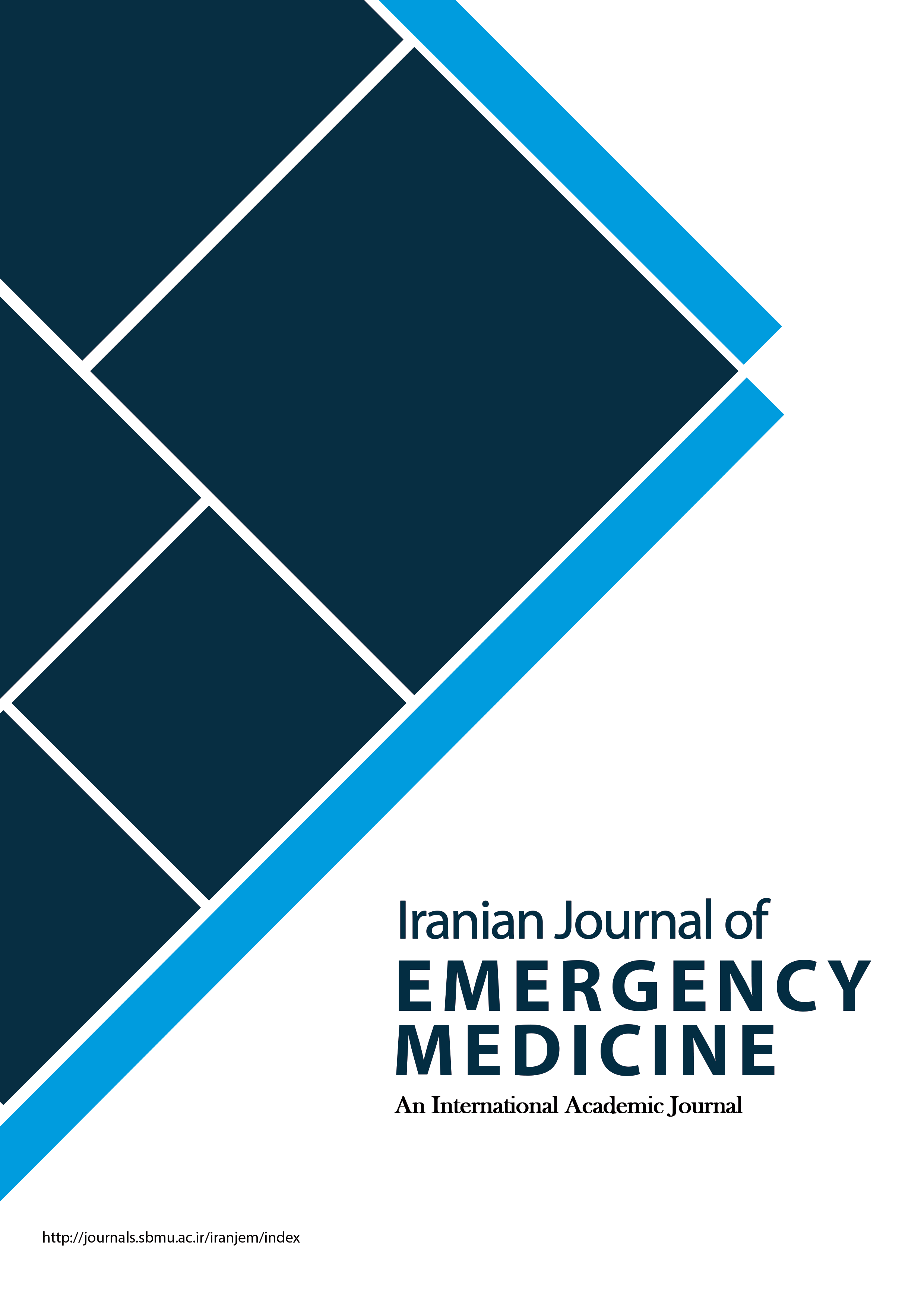Time Indices of Emergency Medical Services; a Cross-Sectional Study
Iranian Journal of Emergency Medicine,
Vol. 5 No. 1 (2018),
8 February 2018
,
Page e8
https://doi.org/10.22037/ijem.v2i1.18192
Abstract
Introduction: Considering the importance of the role and function of emergency medical services (EMS) in a society’s health and the need for continuously evaluating its function, especially in indices affecting the process of giving service to the patients, the present study was done with the aim of comparing time indices of providing services in EMS during two 6-month periods 1 year apart throughout Zanjan province, Iran. Methods: This study was a retrospective cross-sectional study. Out of all the calls recorded in EMS centers of Zanjan province during October to March 2013 and 2014, 742 calls that had resulted in the patient being transferred to a hospital were randomly selected and the required data including time indices and population indices were extracted from EMS forms that are filled by a medical emergency technician for each mission. Results: Among the total of 742 patients transferred by EMS during October to March 2013 and 2014, 452 were male and 290 were female. Mean age of the patients was 28 years. Most calls to EMS were related to trauma due to accident (345 cases) and internal (114 cases), respectively. Regarding time indices, mean times observed, respectively, were 0.02 minute (delay time), 8 minutes (response time), 10 minutes (time to reach the scene), 20 minutes (total of the 3 mentioned times), 27 minutes (time to reach hospital), 94 minutes (total mission time). Only 2 time indices, namely time to reach hospital (t=3 and p=0.001) and total mission time (t=2 and p=0.009), were significantly different between the studied periods and no significant difference was detected regarding other time indices. Conclusion: Based on the findings of this study, time indices of EMS were desirable and at the same level as national and international indices. Meanwhile, differences in time indices were only significant regarding time to reach hospital and total mission time and these indices were lower in 2013 compared to 2014.- فوریت های پزشکی؛ پیش بیمارستانی؛ مطالعات زمان
How to Cite
References
Bahadori M, Ghardashi F, Izadi AR, Ravangard R, Mirhashemi S, Hosseini SM. Pre-Hospital Emergency in Iran: A Systematic Review. Trauma Monthly. 2016;21(2):e31382.
Panahi F, Mohebbi HA, Farahani MA, Khoddami Vishteh HR, Assari S. Prehospital Emergency Service for Internal Medicine Problems in Pediatrics; Causes, Time Indices and Outcomes. Iranian Journal of Pediatrics. 2007;17(Suppl 2):179-85.
Bidari A, Abbasi S, Farsi D, Saeidi H, Mofidi M, Radmehr M, et al. Quality assessment of prehospital care service in patients transported to hazrat-e-rasoul akram hospital. Medical Journal of Tabriz University of Medical Sciences. 2007;29(3):43-6.
Nasiripour AA, Bahadori M, Tofighi S, Gohari M. Analysis of the relationships between the determinants Influential in performance of prehospital emergency system of Iran using the DEMATEL Approach. Health med. 2010;4(3):567-72.
Sohimi MB, Abbas WFB, editors. The prioritization factors of Enterprise Application Integration (EAI) adoption in Malaysian e-Government. Research and Innovation in Information Systems (ICRIIS), 2011 International Conference on; 2011: IEEE.
Khankeh H, Alinia S, Masoumi G, Ranjbar M, Daddoost L, Hosseini S, et al. Prehospital services by focus on road traffic accidents: Assessment developed and developing countries.
Journal of Health Promotion Management. 2013;2(2):71-9.
Nasiripur A, Bahadori M, Tofighi S, Gohari M. Prehospital emergency performance in Iran View of comprehensive coverage plan. Journal of Critical care nursing. 2010;2(4):3-4.
Bahadori M, Ravangard R. Determining and Prioritizing the Organizational Determinants of Emergency Medical Services (EMS) in Iran. Iranian Red Crescent medical journal. 2013;15(4):307-11.
Momeni M, Salari A, Ghanbari A, Shakiba M. Sex Differences In Duration Of Pre-hospital Delay In Patients With Acute Myocardial Infarction. Journal of Payavard Salamat. 2013;7(2):133-42.
Ebrahimian A, Khalesi N, Mohamadi G, Tordeh M, Naghipour M. Transportation Management in Pre-hospital Emergency whit Physiological Early Warning Scores. Journal of Health Administration. 2012;15(49):7-13.
Limprayoon K, Sonjaipanich S, Susiva C. Transportation of critically ill patient to pediatric intensive care unit, Siriraj Hospital. J Med Assoc Thai. 2005;88(Suppl 8):S86-91.
Panahi F, Khatami M. Azizabadi farahani M, Khodami vishteh H, Asari SH. Indices when pre-hospital emergency services for children in Tehran Iran University of Medical Sciences (Razi Medical Sciences). 2008;15(58):69-80.
- Abstract Viewed: 1697 times
- PDF (فارسی) Downloaded: 904 times
- HTML (فارسی) Downloaded: 252 times



